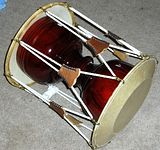J is for Janggu.
(Title is linked to a Wikipedia article on janggu, much of which is also quoted below.)
This is a janggu..

.. one of four percussion instruments used in Samul Nori, or traditional Korean drumming. I was persuaded this past spring to join a Samul Nori ensemble group on campus and I'm now officially hooked.
First, a bit more information on the drum itself:
From Wikipedia, the free encyclopediaSo far I've learned three songs (Tego Sori, Young Nam Farmer's Music, and Hae Do Ji) and performed a couple of times with the ensemble. I'll learn the fourth song that the ensemble performs this summer. When we practice and perform, we sit on the floor with the drums in front of us (though there are some songs when the buk's are up on stands), set slightly off center to the left.
Janggu is the most widely used percussion instrument in most kinds of Korean traditional music. It is made from a hollow wooden body and two leather skins. The two sides produce sounds of different pitch and tone, which then played together, represents the harmony of man and woman.
The oldest historical record about this hourglass drum can be traced to the reign of King Munjong (1047-1084) of Goryeo. This instrument has been found both in a mural painting of Goguryeo tomb and in the bell inscriptions belonging to the Silla period. Whereas the Buk is used to accompany vocal music such a Pansori, the Janggu is usually classified as an accompanying instrument because of its flexible nature and its agility with complex rhythm. Janggu is one of the leather percussion instruments consisting of an hour-glass shaped body with two heads (hides or skins) lapped onto metal hoops placed over the open ends of the body and secured by counter-hoops. It goes by the name either Janggu or Janggo, also sometimes called Seyogo (slim waist drum) because of the large heads and its slim waist.
The left head ('Buk' side) is covered with a thick cowhide, horsehide, or deer skin and produces deep and low tones. The right side ('chae' side) is usually covered with a lighter horsehide and produces higher tones. Either porcelain, tile, metal, wood, guard, or tinned sheet can be used to make the body. Popular choices are poplar and paulownia woods. However, paulownia is most popular because it is the lightest and the best resonating material that produces beautiful sounds. The round tube in the middle connecting the left and right side of the hour-glass shaped body is called Jorongmok. The size of the Jorongmok determines the quality of tone: the wider the tube, the deeper and huskier it sounds; the narrower the tube, the harder and snappier it sounds.
{..tangent snipped..}
There are two kinds of sticks (chae)- 'Gungchae' and 'Yeolchae'. Gungchae is made from a bamboo root, boiled and straightened out. A hardwood, such as birch, or antler bone is fitted onto the end of the stick. Yeolchae is made from a bamboo stick.
Since the performer can use his/her hands as well as sticks, various sounds and tempo, deep and full, soft and tender, menacing sounds, and fast and slow beats - can be created to suit the mood of the audience. Using this capability, a dexterous performer can dance along moving his/her shoulders up and down and make the audience carried away and dance along with him/her. The way performers carry the Janggu differ from person to person, from region to region and varies depending on his/her taste.
The music is not written in standard Western notation, and Young Nam Farmer's Music is written in a different notation from the other two pieces, so it took some time just to get oriented to the notation. There are three basic "notes" - a single hit on the left head with the Gungchae (Koong), a single hit on the right head with the Yeolchae (Ta), and hitting both heads at the same time with their respective chae (Doong). Additionally, you can cross over either chae to hit the opposite drum head (though left cross overs (hitting the right head with the Gungchae) have been most common in the pieces I've learned so far). Either chae can also be struck against the edge of either drum head - which produces more of a "click" instead of a "boom" - or struck together. Tego Sori (large audio file - 5.3 MB) has examples of all of these sounds, though it's difficult to tell which ones are produced by which methods without seeing a performance.
Janggu aren't terribly expensive, but are only available in Korea (or at least, the ones we use are), so the shipping can get exorbitant. Fortunately, if you know someone going over, they can bring a drum back with them in their checked luggage. I know two people going to Korea this summer and one has agreed to bring a drum back for me, so hopefully sometime in the next couple of months I'll have my own janggu. Until then, I'm borrowing one of the University's janggu so I can practice at home between our weekly rehearsals and catch up with the rest of the ensemble (which has been practicing off and on for about three years).
Note: This is now the third time I've completely re-written this post. I've tried to remember to get everything in with each re-write, but if something doesn't make sense or you have questions, let me know and I can fill in stuff I've missed.


1 comment:
Who plays the janggu? Do they wear anything special?
Post a Comment